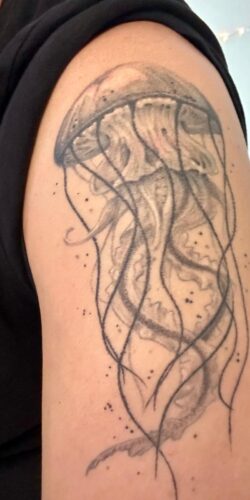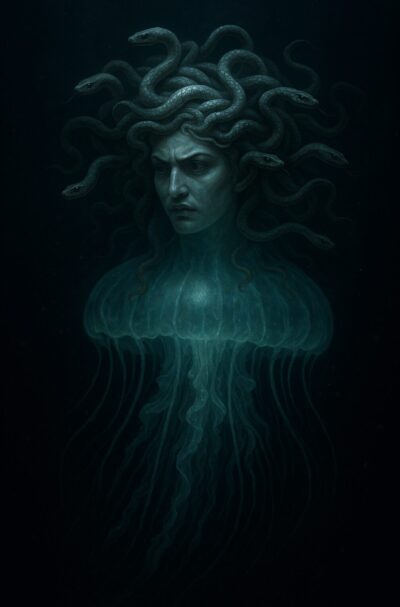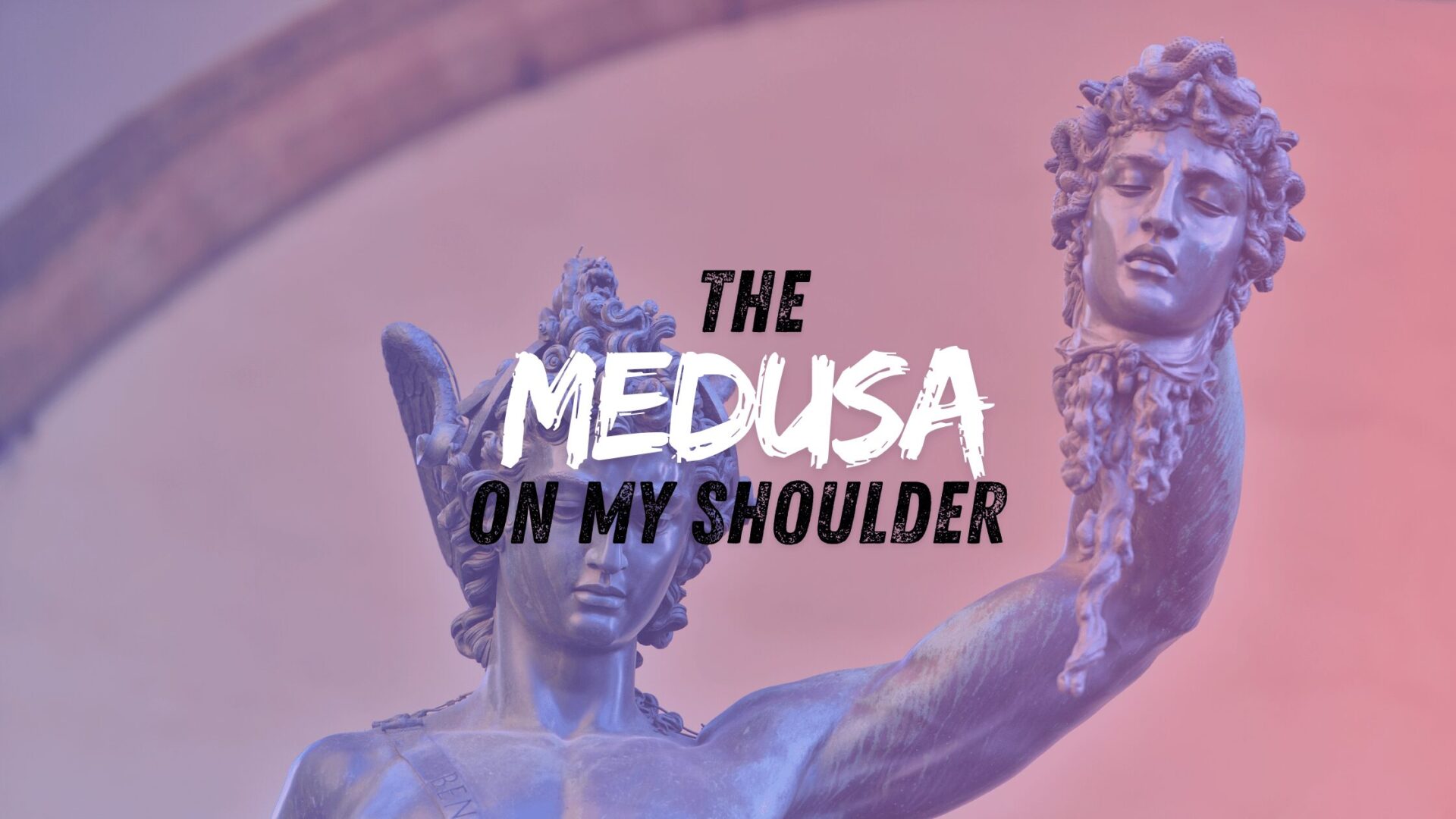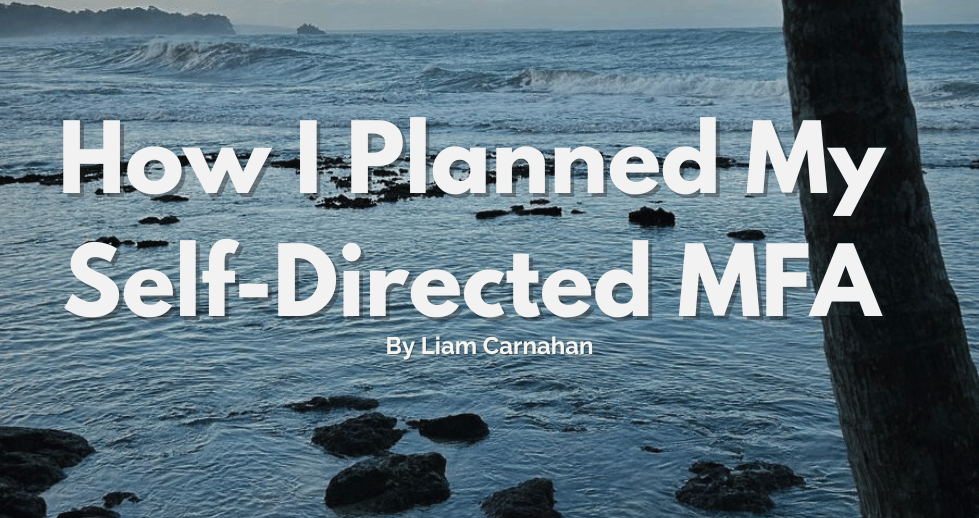Jellyfish have become an obsession for me.
I’ve only ever been stung once—well, twice, sort of.
The first was while swimming at night in a bioluminescent bay in Puerto Rico, almost twenty years ago.
The second (sort-of) sting happened this February, just about 24 hours before my appointment to get this tatooed on my shoulder:

Strange, no? I obviously didn’t plan to get stung, but I’d been thinking about getting this tattoo for some time, and had the appointment scheduled for over a week.
I seem to be haunted by the ghostly jellyfish these days, which is indeed why I sat in a chair for five hours to get this tattoo. It has been this way since I made them the first big metaphor in my memoir.
In the prologue, the narrator (aka me) is sitting on a cliff, overlooking a beach, and ruminating on the concept of danger.
Having lived in Australia for six years, I was always on the lookout for the dangerous creatures that were seemingly around every corner—I cover a few of these in the opening of my memoir:
Not long after I survived the tides at Tamarama, I came across a red-bellied snake, coiled on the sidewalk outside my office. The city put orange cones around it and a sign warning people to stay away, which baffled me. Won’t it just slither through the cones? Shouldn’t someone capture it and get it out of the way?
But no one did, and it didn’t move an inch for three days. Then it was gone, off to sunbathe somewhere with less foot traffic.
A year later, there was the redback spider, crawling toward my bare foot from under the crack in the door of my bungalow apartment in Newtown. I leaped onto the kitchen counter and called Marc, my boyfriend.
“Stop screaming and spray it with Raid,” he said.
Whimpering, I fetched the can from under the sink and crept over to the miniscule killer hiding under my desk. She would have been invisible, if not for the neon red triangle on her back. I sprayed once, and resumed screaming when hundreds of her tiny babies scurried out from underneath her thorax. I emptied the can of Raid.
There was the time I nearly stepped on a stone fish, or when I made eye contact with a muscular red kangaroo, or watched two goannas fight over a piece of toast with jam. My mother was most fond of the story about the magpie, which, convinced I was after its eggs, dive-bombed me, pecking my bike helmet as I pedaled through a park.
I wonder, now, if all these not-so-close encounters gave me a false sense of security. Perhaps I saw them as proof of my natural survival skills, my unshakable good fortune. Danger would always be happening just over there, to someone else. And if it ever came for me, surely I would be clever enough to see it coming and get out of the way.
Eventually, I get to the creature in Australia that fascinated and frightened me the most—the irukandji jellyfish. I describe it like this:
Their boneless bodies are bell-shaped and nearly transparent. They are only as long as a needle, but behind them they trail four lethal tentacles, which can grow over three feet long. If one of these tentacles brushes any part of your skin, it won’t hurt at first; no more than a mosquito bite. The vomiting, the nausea, the violent seizures come an hour or so later. Then, waves of pain in your lower back that radiate through your joints. Your blood pressure will drop, and if you are going to die, that’s what will kill you. But even those who survive are often convinced they are going to die, because the irukandji wages psychological warfare. The book on the boat punctuated the long list of symptoms with this: Many victims experience an impending sense of doom.
Except from the Prologue of The Year of Tiny Monsters
I spent so much time writing and thinking about jellyfish that they soon became a meta-symbol for my memoir itself, the process of writing a book, and for my outlook on life in general.
I don’t kid myself; I know some day, an editor may fish the irukandji out of my manuscript. It won’t matter—it still represents this project, which has already been a turning point in my life.
In the memoir, the jellyfish is the stand in for invisible danger and frightening beauty. But the jellyfish had a deeper symbolism, one that represents the journey I’ve been on since I left my abuser.
Jellyfish have very little control over the direction they travel. They have no choice but to move with the tides. Their tendrils and bells help them dance and move with those tides—but they do not resist the currents of the ocean.
In my memoir, you’ll read about how the tides of life threw me into several horrible situations, and watch me struggle to maintain desperate control of my situation.
With hindsight, I can see now that all the struggling only made things worse. Now, I strive to be more like an elegant jellyfish—accepting of the tides and riding the waves with grace and beauty. And like the jellyfish, I need to learn to set boundaries that keep me safe. Still working on that.
All that meaning, packed into one tiny, almost invisible creature.
It was a no-brainer to get the tattoo, but I wanted to wait until the right moment.
That moment came in Costa Rica, on the last day of my month-long solo writing retreat there—part of my self-directed MFA.
I was wading in the waves of the warm waters in that beach town, mulling over whether it was a good idea to get a tattoo in a foreign country, the day before I got on a plane.
Then, I felt a little sting—right between my two smallest toes. I ran out of the water, because as I’ve learned in my research, the littlest stings can cause the most pain later. I quickly searched up what it might have been—sure enough, the beach where I was swimming had occasional jellyfish activity. What I felt was harmless, most likely sea lice—aka baby jellyfish. (Who knew?)
This close-but-harmless encounter, so evocative of what my memoir was about, gave me the courage to go to my appointment with Damian, the owner of the little tattoo shop on the top floor of the turquoise bungalow house near the beach, for what I knew would be a much more stinging experience.
Enter Medusa
Damian was from Argentina, and he looked the part of a beachside tattoo artist—tan skin, dreadlocks, a friendly smile, and a kaleidoscope of artwork across his skin. We made small talk during the long appointment, switching back and forth from English to Spanish.
Early on in the session, I realized I had no idea how to say “jellyfish” in Spanish.
“Como se dice eso…” I said, indicating the stencil on my shoulder, only partially inked in.
“Medusaaaa,” Diego said.
Well I’ll be damned, the Spanish language did it again. It’s the perfect name—those long tendrils, the ethereal beauty, the hidden danger. “Jellyfish” is a great word in its own right, but the poetry of calling this creature a Medusa is unparalleled.
(A friend in my writing group informs me that the Israeli langauge also uses this word: meduza.)

Since learning this fact, I’ve been digging into Medusa’s story.
Many interpretations of Medusa’s story see her as a victim of abuse. She is assaulted by Poseidon in Athena’s temple, and then slut-shamed in the worst possible way—turned into a Gorgon, given snakes for hair, and exiled to live in a cave with the other two living Gorgons.
Men, as they are wont to do, travel to the cave to commit acts of violence against Medusa and her sisters in a suitably ridiculous display of machismo. Medusa stands her ground, turning them into stone with her glare.
Then, the demi-God Perseus comes along with his shield that shines like a mirror, his winged shoes that help him run like the wind, his invisibility cloak that conceals his escape.
He creeps up on Medusa while she’s sleeping, using his mirror-shield to protect himself from her gaze, until he’s close enough to chop off her head and make a break for it under the cloak.
The more I think about this story, the more parallels I can see between Medusa’s tragic tale and my own. But I’m not certain whether I’m Medusa or Perseus.
I did, after all, suffer assault and a few injustices that can be blamed, at least in part, on fate and circumstances—the Gods, if you will. I was taken advantage of, targeted by my abuser for no apparent reason, and nearly paid for it with my life.
But also… I escaped the monster. And I did it by taking a long look in the mirror, and then disappearing into the ether so that my abuser could never find me again. That is Perseus-coded, no?
Perhaps I am all of these things—a survivor who defeated a villainous beauty, a misunderstood monster who needed to look in the mirror. A stinging jellyfish caught in a current, doing its best to ride the tides.


